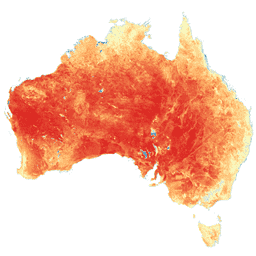
- Disponibilidad del conjunto de datos
- 2000-02-01T00:00:00Z–2025-09-01T00:00:00Z
- Proveedor del conjunto de datos
- TERN Landscapes / CSIRO Land and Water
- Etiquetas
Descripción
Este conjunto de datos proporciona la evapotranspiración real (AET o ETa) precisa para Australia con el algoritmo CMRSET. La banda de AET (denominada "ETa") contiene el valor diario promedio del modelo CMRSET para todas las observaciones de Landsat sin nubes de ese mes (indicado con el valor 3 en los bits de QA de la fuente de datos de AET). Después de que el corrector de líneas de exploración (SLC) del ETM+ de Landsat 7 falló el 31 de mayo de 2003, los datos del ETM+ de Landsat 7 solo se usan si no hay datos del TM de Landsat 5 o del OLI de Landsat 8 sin nubes para ese mes. Si no hay datos de Landsat sin nubes disponibles, los píxeles se rellenan con datos combinados. Los datos combinados serán una combinación de Landsat y MODIS hasta febrero de 2012, y luego una combinación de Landsat y VIIRS (indicado con el valor 2 en los bits de QA de la fuente de datos de AET). Si no hay datos combinados disponibles en un mes, los valores mensuales faltantes del AET se interpolan de forma lineal (se indican con el valor 1 en los bits de QA de la fuente de datos del AET). Esto significa que los datos de AET mensuales de 30 m que abarcan toda Australia, sin brechas debido a las nubes, están disponibles y listos para usarse.
La información precisa sobre la AET es importante para el riego, la seguridad alimentaria y la administración ambiental. Al igual que en muchas otras partes del mundo, la disponibilidad de agua en Australia es limitada, y la AET es el componente de consumo más grande del balance hídrico. En Australia, el 70% del agua disponible se utiliza para el riego de cultivos y pastos. Una mejor supervisión permitirá mejorar la eficiencia en el uso del agua en este sector, y cualquier ahorro de agua estará disponible como caudales ambientales. Además, los ecosistemas dependientes de aguas subterráneas (GDE) ocupan un área pequeña, pero son "puntos críticos de biodiversidad". Conocer sus necesidades de agua permite mejorar la gestión de estas áreas críticas. La AET también se puede usar para modelar el balance hídrico de la cuenca. Si se usa en cálculos de balance hídrico (balance de masa), este valor de AET se debe multiplicar por la cantidad de días del mes.
Para que los desarrolladores sepan que usas este conjunto de datos, obtener información sobre las actualizaciones o si tienes alguna pregunta, comunícate con tim.mcvicar@csiro.au, tom.vanniel@csiro.au o jamie.vleeshouwer@csiro.au.
Bandas
Tamaño de los píxeles
30 metros
Bandas
| Nombre | Unidades | Tamaño de los píxeles | Descripción | ||||||||||||||||||||||||||||||||||||||||||||||||||||||||||||||||||||||||||||||||||||||||||||||||
|---|---|---|---|---|---|---|---|---|---|---|---|---|---|---|---|---|---|---|---|---|---|---|---|---|---|---|---|---|---|---|---|---|---|---|---|---|---|---|---|---|---|---|---|---|---|---|---|---|---|---|---|---|---|---|---|---|---|---|---|---|---|---|---|---|---|---|---|---|---|---|---|---|---|---|---|---|---|---|---|---|---|---|---|---|---|---|---|---|---|---|---|---|---|---|---|---|---|---|---|
ETa |
mm/d | metros | Evapotranspiración diaria promedio |
||||||||||||||||||||||||||||||||||||||||||||||||||||||||||||||||||||||||||||||||||||||||||||||||
pixel_qa |
metros | Atributos de QA de píxeles |
|||||||||||||||||||||||||||||||||||||||||||||||||||||||||||||||||||||||||||||||||||||||||||||||||
Condiciones de Uso
Condiciones de Uso
Citas
Juan P. Guerschman, Tim R. McVicar, Jamie Vleeshower y Thomas G. Van Niel, Jorge L. Peña-Arancibia, Yun Chen. Estimating actual evapotranspiration at field-to-continent scales by calibrating the CMRSET algorithm with MODIS, VIIRS, Landsat and Sentinel-2 data, Journal of Hydrology, Volume 605, 2022, 127318, doi:10.1016/j.jhydrol.2021.127318.
DOI
Explora con Earth Engine
Editor de código (JavaScript)
var dataset = ee.ImageCollection('TERN/AET/CMRSET_LANDSAT_V2_2'); var visualization = { bands: ['ETa'], min: 0, max: 7, palette: ['d7191c', 'fdae61', 'ffffbf', 'abd9e9', '2c7bb6'] }; Map.setCenter(132, -27, 4); Map.addLayer( dataset, visualization, 'Average daily evapotranspiration (mm/day)');
